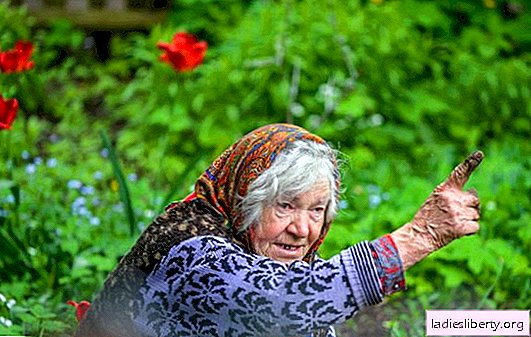
Naturally, today on every bag of seeds and in books about garden crops and varieties it is easy to find the recommended planting dates for everything. However, it is often possible not only to adhere to them, but also to be guided by the calendar of folk wisdom, taking for reference, for example, such events in nature:
- snowdrops showed up - It's time to sow artichokes, kohlrabi and tomatoes for seedlings;
- flowering bird cherry - plant a plot of potatoes;
- bloomed chestnut - time to plant beans, radishes and radishes;
- lilac bloom - in the garden it's time to appear zucchini and pumpkin, cauliflower and a lettuce;
- when nettle got a second row of leaves - it's time to plant late varieties of white cabbage;
- bloomed violets - you can sow parsley, dill and carrots;
- cherry blossoms - time to plant fragrant greens that are moody to heat (for example, marjoram, basil and thyme);
- viburnum blossomed - plant beets and squash;
- flowered turn - planting corn;
- bloomed dog rose (rosehip) - plant cucumbers, tomatoes, eggplant and sweet peppers in open ground;
- blooming mother and stepmother and hazel - You can send crops resistant to cold, including spinach, horseradish, rhubarb, sorrel, turnips, to the open ground.
To the flowering of coltsfoot should be removed from the site until the end of last year's foliage.
There are signs for florists:
- crocuses seen in the forest - time to sow delphinium;
- snowdrops appeared - you can plant asters and petunias.
If you are afraid to freeze thermophilic crops, you need to wait until the red mountain ash blooms - after this event, the frost will no longer return.
The above signs exist for a reason, but in many respects they have a strictly scientific explanation. Indeed, many plants bloom when not only air, but also the soil warms up to a certain temperature.
For example, bird cherry blossoms happen when the soil warms up to 8 ° C, and for lilacs the temperature should reach 12 ° C.
There is other evidence of a better time for planting, not related to nature:
- a pumpkin is planted on weekends (the old name is market day) or Tuesday;
- peas are best sown while the sun rises;
- sowing sunflowers is planned for Saturday, before sunrise or after sunset;
- the best day for planting potatoes is when the sky is clear and bright blue, decorated with fluffy white clouds.
But the first day of every month is considered an unfavorable day for planting anything.
Sowing and planting can be split in half - when the moon grows, "populate" the site with what grows above the ground (for example, peas), and when the moon wanes - by what ripens underground (say, radish). Also a suitable day for planting root crops is the full moon.
And for sowing the most fanciful crops, it is better to leave women's days - Wednesday and Friday.
And without exception, you need to plant without prying eyes. That is, there should not be guests, and it is better for neighbors not to look through the fence. Perhaps no one will wish evil, but simply - they can even accidentally jinx it.
In addition, you should not lend or borrow anything during the sowing season.
In the old days, hiring a worker, the owner called him to dine at the same table and looked closely - if he ate men with appetite, then he would work hard, and if he ate somehow, the assistant from him was useless. There is a logical explanation for this - the labor requires strength, so a person should eat seriously.
Today this custom has changed a bit - Before gardening, you need to eat a hearty meal, because if everything is done on an empty stomach, there will not be a good harvest.
Also, so that everything grows well and does not ail the plants, it is supposed to work in a good mood - you can not be angry, angry, sad about how heavy the share of the gardener is.
To spoil the crop by lowering it or by luring pests can also be other incorrect behavior.
It is impossible:
- chatting when sown sunflower;
- click on the seeds in the garden, as well as gnaw nuts;
- laugh - when they arrange zucchini on the beds;
- plant watermelons and melons in boots;
- to be in shoes when celery is sent to the beds;
- to have iron parts on clothes when sowing beets.
So that pests and diseases do not touch the plantings, one can hope not only for chemicals and folk recipes, but also take such actions:
- sprinkle between the beds quite a bit, just symbolically, a mixture of granulated sugar, ground coffee and wood ash;
- drive six pegs of oak wood along the perimeter of the garden (it is interesting that a similar action, but with aspen stakes, protects the crop from robbers).
Specifically, a red paper flower, stuck on a stick-stalk from the side of the garden where the sun rises, protects from caterpillars.
And so that no one bites the leaves of plants, you can use this recipe:
- dissolve a spoonful of honey in half a cup of milk;
- find a place in the garden where weeds grow far from cultivated land;
- pour the sweet liquid onto the weeds by adding such a plot:
- "here you have pests gnawing on a sweet treat, and feast here, but don’t dare to get to the host harvest."
If no fruits are tied to the cucumbers, you need to break off a handful of their flowers at dawn and throw it on the road along which the village herd leaves to graze.
You can hope for a good harvest if:
- in February, winds blow from the north;
- the last icicles in spring are very large;
- in ponds (puddles) a lot of tadpoles were noticed;
- on the earth after the snow has fallen, cracks appear;
- in March a strong thunder is heard;
- at the end of December there was frost on the trees;
- March was dry;
- acorns appear abundantly on oaks;
- in winter, the domestic cat keeps close to the heat sources in the house and often cleans itself;
- June nights are dark;
- in the middle of summer there are many mosquitoes;
- in the morning the fields are decorated with abundant dew;
- in June, lightning was noticed;
- in winter there was thick ice on lakes and rivers.
And also it is unlikely to please the crop if:
- among spring icicles there are many hollow;
- spring came much earlier than usual;
- the cuckoo sang before the trees dressed in young greenery;
- a lot of cobwebs flies in the forest;
- winter was not snowy.











